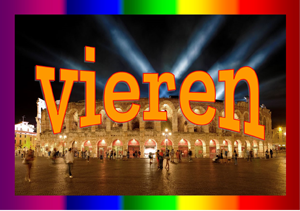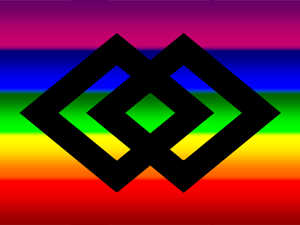By Greg Suffanti
QFWF no. 5, June 13th 2018
Buddha of Infinite Compassion
The Buddha of limitless transcendence… Including gender
Quan Yin, Kuan Yin, Guan Yin, Guanshiyin or Kannon, … , meaning the “One Who Hears the Sounds (suffering) of the World”, is revered as an Asian Bodhisattva, deity, Buddha, or enlightened being, associated with mercy and compassion.
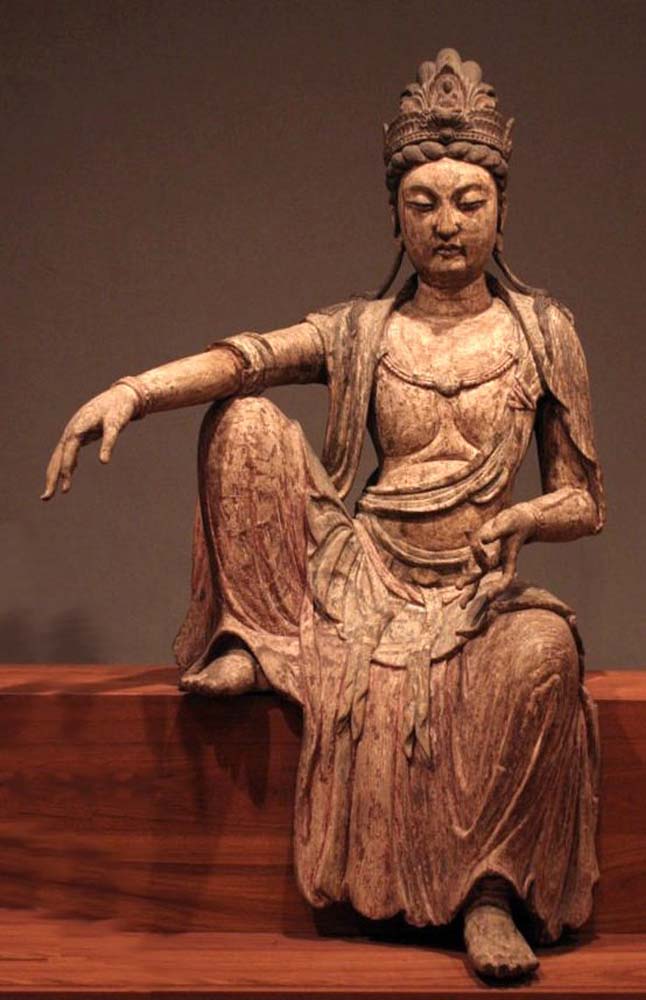
Although Quan Yin is known by many names in the many lands where she/he is venerated, all the different names refer to one being.
In Tibet, Quan Yin is known as the male deity called Chenrezig or Avalokiteshvara. In English, Quan Yin is known as the Goddess of Mercy.
A Bodhisattva is any being who generates Bodhicitta, which is the altruistic wish to attain Buddhahood for the benefit of all sentient beings. Sentient beings include all beings who have a mind/consciousness. The depictions of Quan Yin as either male or female demonstrate this Buddha’s limitless transcendence, including gender. In each land where the deity has appeared, he/she has remained wildly popular to this day.[2]
Take the form of any type of king, god, Buddha or Heavenly Guardian
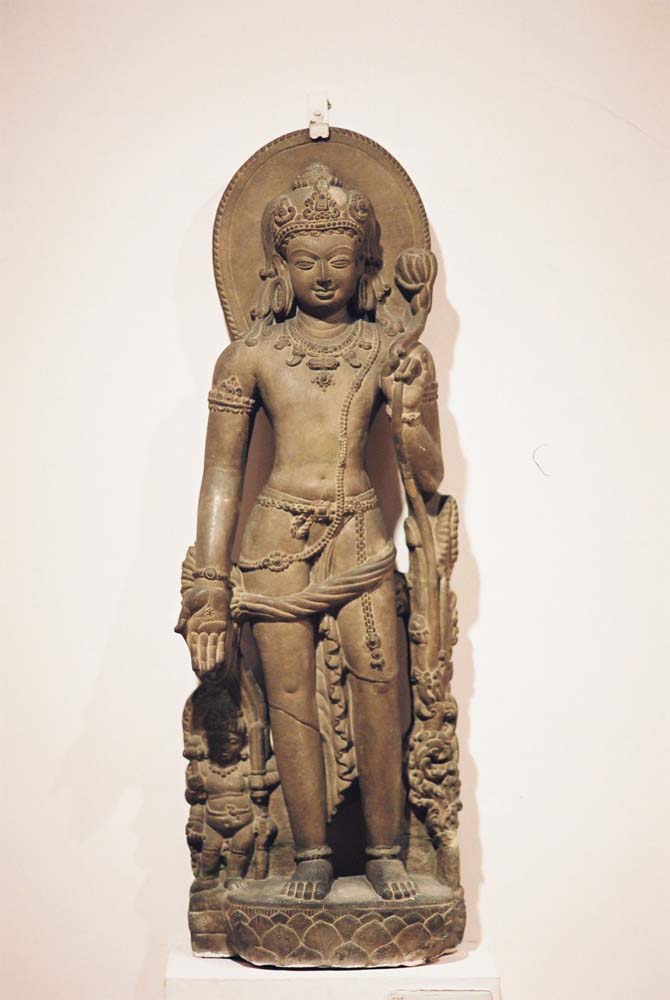
The origins of Quan Yin can be traced back to India, where he was known as the Bodhisattva Avalokiteshvara.
The Lotus Sutra, which is one of the most widely used Mahayana (Great Vehicle) Buddhist sutras, is generally accepted to be the earliest text expounding the doctrines of Avalokiteshvara.[4]
“The Lotus Sutra describes Avalokiteshvara as a Bodhisattva who can take the form of any type of God including Indra or Brahma; any type of Buddha, any type of king or Chakravartin or even any kind of Heavenly Guardian including Vajrapani and Vaisravana as well as any gender male or female, adult or child, human or non-human being in order to teach the Dharma to sentient beings.”[5]
The teachings of the Buddha are called the Dharma.
Human beings at that time were unable to comprehend the Lotus Sutra
According to the Mahayana tradition, the Lotus Sutra was a discourse given by the historical Buddha, Shakyamuni, late in his life, and was recorded, because at that time human beings were unable to comprehend its contents.
The teachings of the sutra were then hidden away, so that they might be discovered and used at a later date. The Lotus Sutra was most likely composed in the first century of the common era in Kashmir, during the fourth Buddhist Council, some 500 years after the death of Shakyamuni Buddha.
At that time, “there was a great deal of discussion and disagreement over the legitimacy of Buddhist texts, similar to the struggle of Scholasticism in Christian Europe.”[6]
Quan Yin appears in ways that suit the needs of that country
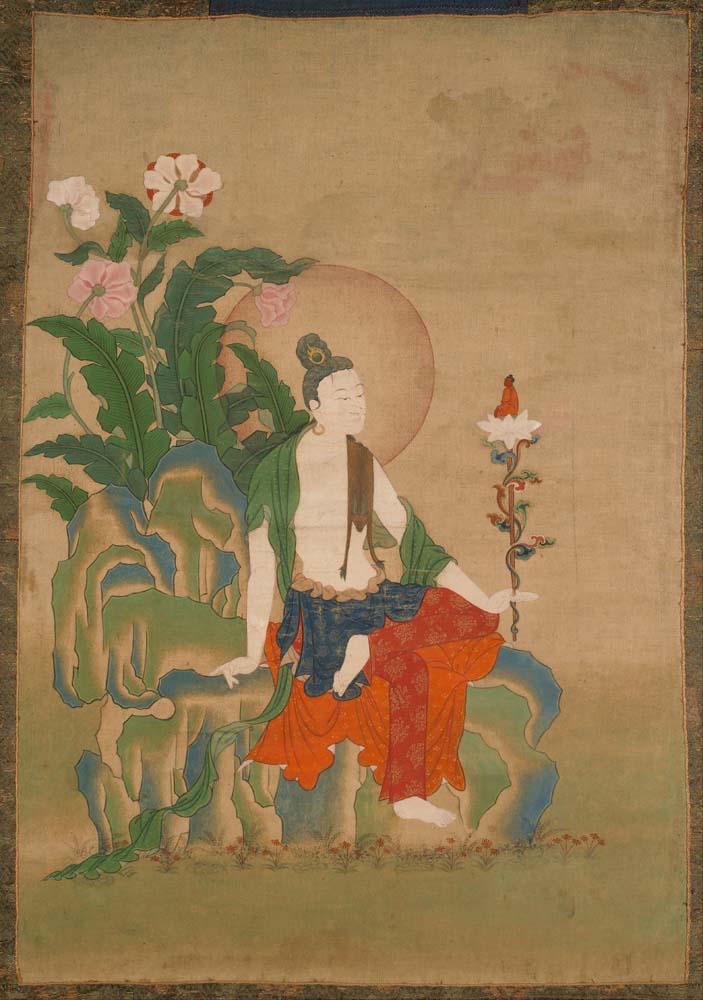
From India and then Tibet, the story of Avalokiteshvara spread throughout the growing Buddhist world, going first to China via the Silk Road trade routes. From China, Buddhism spread via China’s maritime trading routes. Adaptations and changes were made to Avalalokiteshvara’s appearance and background story to suit each country’s cultural and spiritual needs.
There is general scholarly consensus that the monk and translator, Kumarajiva, was the first to refer to Avalokiteshvara in a feminine aspect, in his translation of the Lotus Sutra in 406 CE in his native China.
In all, Quan Yin is said to have 33 different manifestations; each manifestation specifically arising to suit the varied needs of sentient beings. [8]
She is one of the most popular Buddhist deities and is worshipped and revered in China, Japan, Korea, Thailand, Myanmar, Vietnam, Indonesia, Malaysia, Cambodia, Sri Lanka, India and Tibet. There are various depictions of Quan Yin, ranging from a standing image of a beautiful young woman gazing compassionately down on all beings, to a deity with eleven heads and one thousand hands, with an eye on the palm of each hand, to symbolize his/her ability to both see and help all beings who pray to him/her for help.[9]
Quan Yin appears in all schools of Buddhism
Quan Yin appears in both Mahayana and Theravada Buddhism, as well as Vajrayana (Diamond Vehicle), or Tantric Buddhism. Quan Yin is also revered by Chinese Daoist’s.
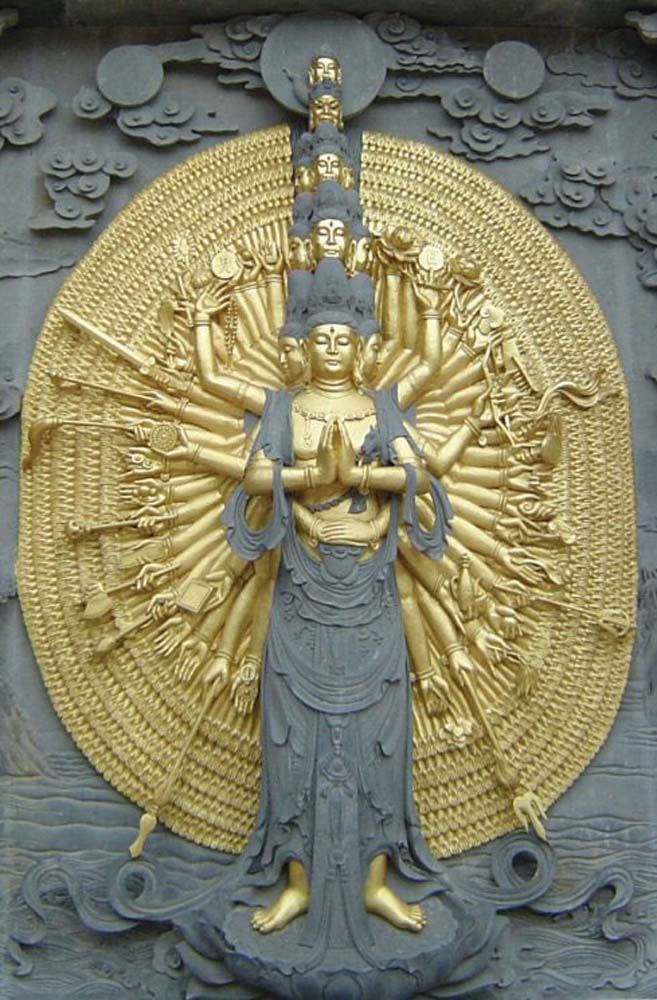
In Cambodia and Thailand, the Buddha is male, and he is known as Lokeshvara or “Lord of the World”.[11] In Tibet, Avalokiteshvara is said to be the earthly manifestation of the self-born eternal Buddha Amitabha, who is said to guard the world in the interval between the historical Buddha of this eon, Shakyamuni Buddha, and the coming of the next Buddha, Maitreya.[11]
Quan Yin appeared in China as early as the 2nd century CE and his image graced all Buddhist temples in China by the 6th century.[9] Representations of the Bodhisattva in China prior to the Song Dynasty (960-1279 CE) were mostly masculine in appearance.
From the time of the Ming Dynasty (1368-1644), Quan Yin has exclusively been portrayed as a beautiful young woman. To this day, Quan Yin shown in female aspect is the way the Bodhisattva is depicted in China, as well in Korea, Japan, Vietnam, Myanmar, Thailand, Cambodia and other Buddhist countries of Southeast Asia.
The Legend of Miao Shan
The Chinese Buddhist saint Miao Shan was a princess who lived around 700 CE. It is widely accepted that she was the inspiration for Avalokiteshvara’s portrayal in a feminine aspect in China.[12] Miao Shan lived during the reign of King Miao Chuang, in the kingdom of Hsing Lin. Images of Princess Miao Shan as a beautiful young woman in white gowns are very similar to those of Quan Yin.
Miao Shan’s dream was to become a nun
In a story told in the “Precious Scroll of Fragrant Mountain”, a wrathful and cruel king named Miao Chuang wanted his daughter, Miao Shan, to marry an uncaring, but wealthy and powerful man.
Miao Shan’s dream was to become a nun and to practice the teachings of the Buddha. Her father was angered when Miao Shan finally agreed to wed, because she stipulated she’d marry any man who could ease the three types of human suffering: aging, sickness and death. Miao’s view was that a doctor would be an appropriate sort of man to choose. The king, furious at this development, ordered his daughter to work, and subsequently had her endure the sufferings of hard labor and near starvation, but all to no avail.
Miao’s dream was still alive to pursue a religious life and she was more determined than ever to attain her goal. She would endure anything in order to follow and study the Dharma.
The king set the temple on fire
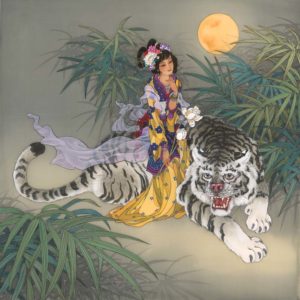
King Miao Chuang finally acquiesced to his daughter’s wishes to work at a temple. However, he ordered the monks to treat her as a lowly servant and to keep her busy day and night. According to legend, the animals surrounding the temple were so moved by Miao Shan’s tireless efforts, that they began helping her accomplish her endless tasks.
The king, upon seeing this, became enraged and set the temple on fire. Miraculously, Miao Shan saved the temple by putting the fire out with her hands, suffering no burns.
Hell is transformed into a paradise
The king was now fearful and so he became determined to have his daughter killed. There are many versions of this story, and most of them involve Miao’s death and her traveling to the Underworld, where she enrages Yama, the Lord of Death.
Miao is overwhelmed by the misery she sees in hell and works tirelessly to the extent that the hell realm is transformed into a paradise.
Accordingly, Yama becomes furious and banishes her back to the world of the living, to the Island of Mount Putuo or “Fragrant Mountain”. While banished to Mount Putuo, Miao Shan continues her efforts to save and alleviate the pain of all sentient beings.
Miao Shan gladly offers her eye and her arm to save her father
In the meantime, King Miao Chuang becomes seriously ill and is told his only hope is to be given the arm and eye of someone without anger.
A monk suggests he visit Mount Putuo, an island southeast of Shanghai, in Zhoushan prefecture of Zhejiang province, where there is a practicing nun who may be able to help him.
Once there, the king recognizes his daughter instantly, breaks down into tears and begs for her forgiveness. Miao Shan gladly offers her eye and arm to save her father and he is healed. Miao Shan then transforms into the Thousand-Armed Quan Yin, forever helping all who pray to her.[14]
The thousand arm representation of this Buddhist deity is first seen in Tibetan Buddhism, which greatly influenced Chinese Buddhism. At various points in the history of Chinese Buddhism, Tibetan Lamas often had high roles and status in advisory roles to the Chinese government. Tibetan iconography was also used and adapted to Chinese tastes.
Quan Yin is an example of a Chinese adaptation of a Tibetan Buddhist deity. The Bodhisattva was greatly altered, in both a physical sense, as well an historic sense, to suit the needs of the Chinese culture.
The sacredness of Mount Putuo is marked with a 33-meter statue of Quan Yin
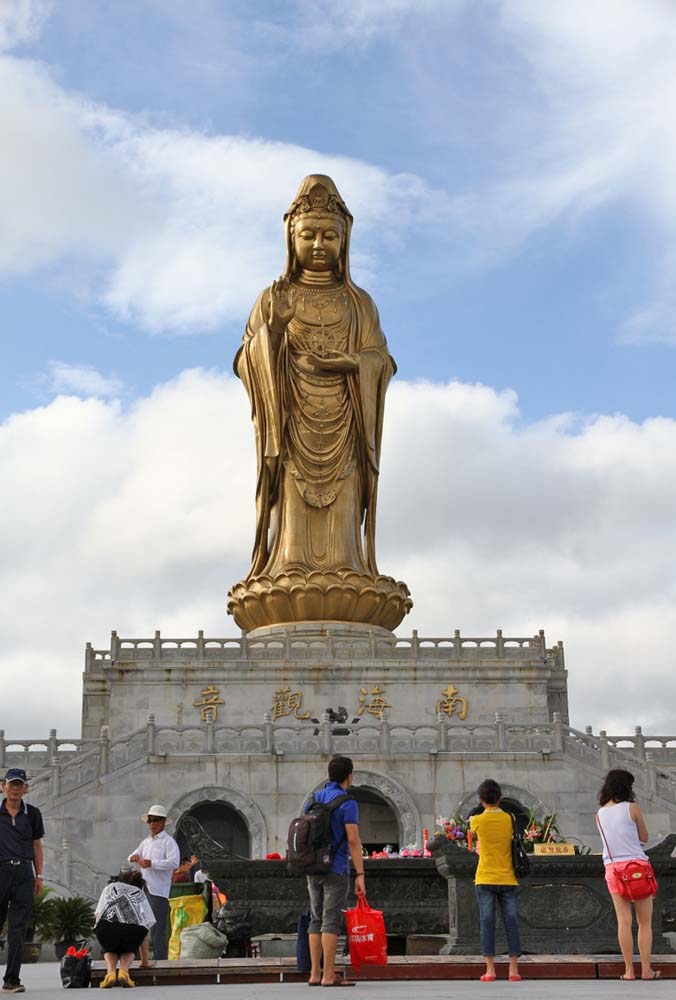
There is today a 33-meter statue of Quan Yin jutting out over the water at Mount Putuo to mark the sacredness of the island. For more than a thousand years, pilgrims have visited the island, regarding Mount Putuo as one of the four sacred mountains of China.
Millions of people visit the site every year to pay homage to Quan Yin, especially on holy days celebrating the birth, death and enlightenment of the Bodhisattva.
The whole island is considered a Bodhimanda, or place of awakening.[16]
Quan Yin the Protector and Savior
Patron Saint of the Seas
Devotees of Quan Yin call on her in times of need and crisis, and there countless stories of her appearing to help those who cry out to her for protection or deliverance from harm’s way.
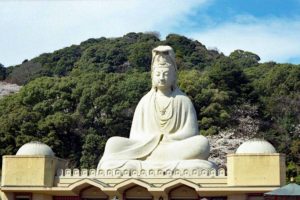
She is widely known and revered and her devotees come from all walks of life. Venerated by women looking to bear children, Quan Yin is also the patron saint of the seas, and fisherman pray to her for safety and deliverance from storms.
There are many sutras mentioning Quan Yin in her various guises, however, it is in chapter 25 of the Lotus Sutra that we learn of the 10 salvations of Avalokiteshvara.
The 10 specific types of help are:
- Protection from the dangers of fire.
- Deliverance from the dangers of water.
- Deliverance from the dangers of falling.
- Deliverance from the dangers of politics.
- Deliverance from prison.
- Deliverance from curses or poisons.
- Deliverance from demons.
- Deliverance from evil beasts.
- Protection during disputes & wars.
- Bestowing children of good fortune.
In chapter 25 of the Lotus Sutra: 1.11 we are told that:
“If there are women who wish to give birth to a son, they should worship by giving offerings to the Bodhisattva Avalokiteshvara, who will bestow on them a son blessed with good fortune, virtue and wisdom. If they wish to have a daughter, they will have a beautiful and adorable daughter blessed with accumulated benevolent roots.”[18]
In Tibetan Buddhism the Dalai Lamas are manifestations of Avalokiteshvara
According to legend, long ago the Bodhisattva Avalokiteshvara, also called Chenrezig, promised the Buddha to help the Tibetans during the darkness of the middle-ages.
It is said that the realization of this promise is the system of the Dalai Lamas, which continues to this day, and which was begun in the fifteenth century.[19]
The Dalai Lamas are believed to be manifestations of Avalokiteshvara
His Holiness the current 14th Dalai Lama, Tenzin Gyatso, has been circumspect when discussing the possibilities of future Dalai Lamas, questioning the efficacy and practicality of the whole system.
Regarding whether His Holiness sees himself as the reincarnation of Avalokiteshvara, his website neither confirms nor denies the assertion, but simply states that in Tibet “the Dalai Lamas are believed to be manifestations of Avalokiteshvara, the Bodhisattva of Compassion, and the patron saint of Tibet.”[20]
Chenrezig’s head exploded into 1,000 pieces
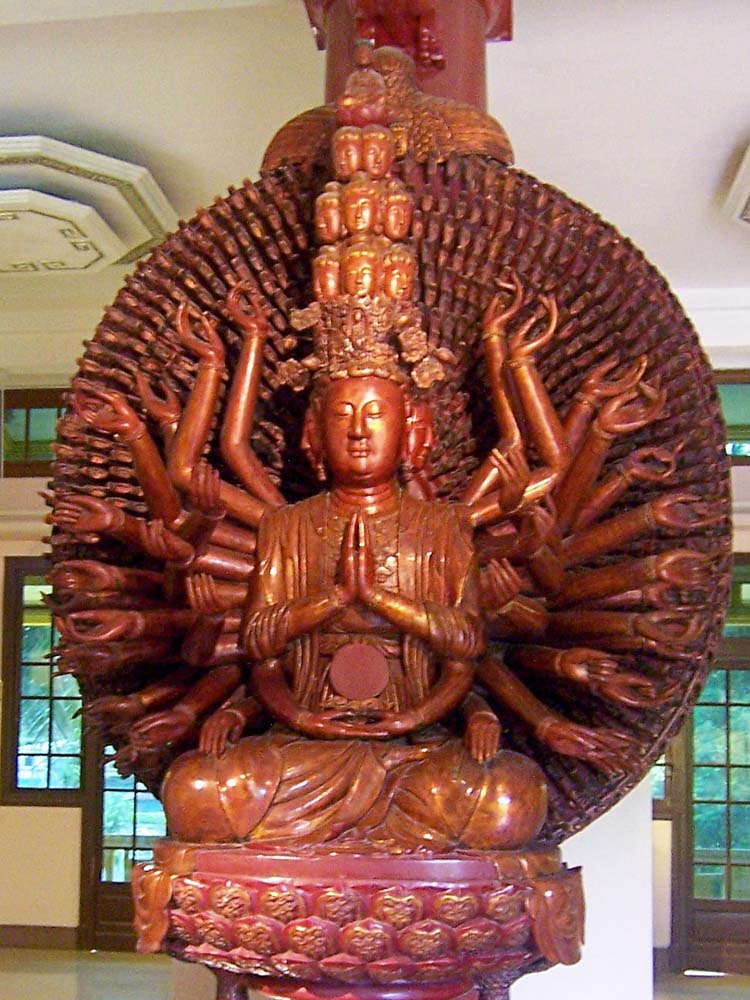
The legend of the origins of Chenrezig tell that he was a manifestation of the self-born Amitabha Buddha. His 1,000 arms are said to have come about because although Chenrezig had made a promise to help all beings, at one point he became so overwhelmed by the suffering around him, that his head exploded into a thousand pieces.
Upon seeing this, Amitabha Buddha put Chenrezig back together again, and this time gave him 1,000 eyes and hands in order to be able to both better see and help all sentient beings.[22]
In addition, Chenrezig has 11 heads, and these are said to symbolize the 10 steps of the Bodhisattva path, plus the 11th head, which represents enlightenment itself.
There are different interpretations as to what all the various elements mean, for example, it is also said that the first 10 heads are Avalokiteshvara, and the 11th head is that of Amitabha Buddha. The 1,000 eyes are said to represent the 1,000 Buddhas of this fortunate eon. Of the 1,000 arms, 992 are in the gesture of supreme giving, which means giving the Dharma.
The other eight arms and hands are depicted as follows:
- The two central hands are joined at the heart and hold a wish-fulfilling jewel.
- The second right hand holds a crystal mala (or rosary).
- The second left hand holds a golden lotus.
- The third right hand is in the mudra of granting siddhis.
- The third left hand holds an Empowerment Vase.
- The fourth right arm holds a Wheel of Knowledge.
- The fourth left hand holds a bow and arrow.
In addition, Chenrezig wears thirteen ornaments, which include a crown, jeweled earrings, a golden belt, armlets, anklets and an upper and lower garment.
Wish-fulfilling jewel
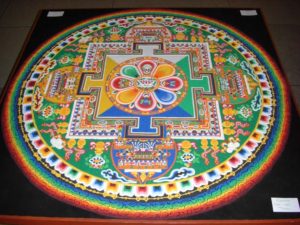
The wish-fulfilling jewel represents the wish-fulfilling capacities of Bodhicitta.
The crystal mala represents the path to liberation; just as one rosary bead follows the other. The golden lotus symbolizes purity; just as the beautiful lotus flower emerges pristine and untouched from the muddy waters in which it grows. Granting siddhis means granting realizations and enlightenment. The Empowerment Vase is full of healing nectar, which purifies all defilements and negativities. The Wheel of Knowledge is symbolic for Chenrezig’s turning the wheel, which means teaching the Dharma.
Finally, it is taught in Buddhism that the path to enlightenment is a combination of method and wisdom: this is represented by the bow and arrow.[24]
Regardless of the differences of opinion in describing the meanings of the various attributes and details of Chenrezig or Quan Yin, in all his/her various guises, all the meanings describe different elements and attributes of the Buddhist path, particularly those associated with wisdom and compassion. Similarly, the many symbols and deities that make up the entire Buddhist canon are also representations of the many ideas, components and concepts that they represent.
Quan Yin: Buddha of many faces & names
Pearls of wisdom
You can find images and statues of Quan Yin standing or sitting, meditating or holding her hands in a mudra gesture, holding the pearls of wisdom or pouring the nectar of wisdom from a holy vase. Quan Yin is alternately depicted as a beautiful young goddess or in more maternal ways, portrayed as a caring mother, holding children or giving out food and blessings. Quan Yin is also a male Bodhisattva, as well as the deity with a thousand hands and eyes and eleven heads.
- In Japan she is called Kannon, Kan’on, or Kanzeon
- In Korea she is called Gwan-eum, or Gwanse-eum
- In Indonesia she is called Kwan Im, or Dewi Kwan Am
- In Khmer she is called Preah Mae Kun Ci Iem
- In Thailand she is called Kuan Im, Phra Mae Kuanlin, or Chao Mae Kuan Im
- In Vietnam she is called Quan Am, Quan The Am, or Quan The Am Bo Tat[25]
Nectar-of-life
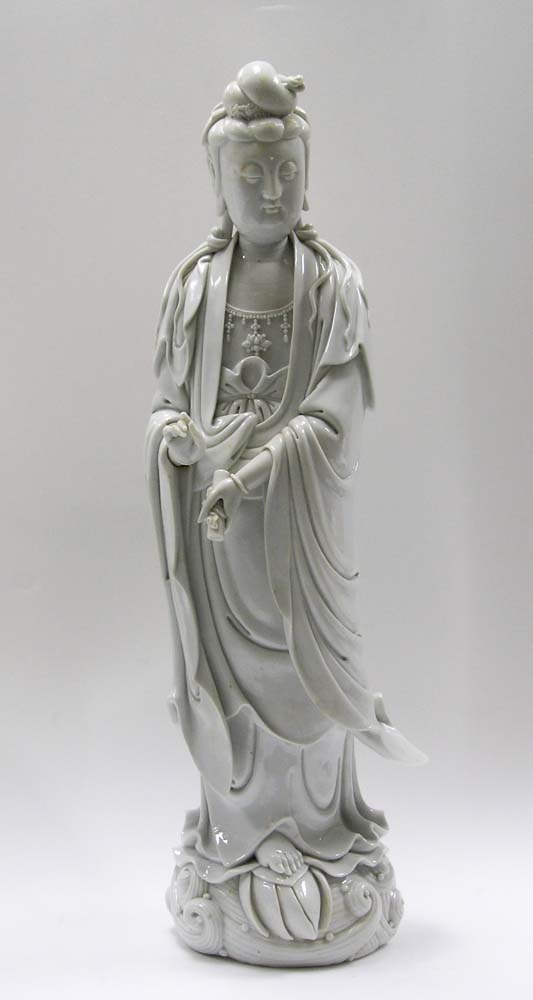
In China, Quan Yin is most often portrayed wearing a white flowing robe, and she is adorned with necklaces indicating both Indian and Chinese royalty.
Other traditions maintain that the necklaces represent enlightenment, while yet others interpret the necklaces, beads one after the other, as being like steps, as Quan Yin leads her followers out of suffering.
Traditionally, she holds a water jug containing pure water in her right hand, and in her left hand she holds a willow branch.[27]
The white robe is a symbol for purity. The water jar is a sacred vase and contains holy water which is the nectar-of-life, blessing beings with both compassion and wisdom.
Other traditions maintain that the holy water heals all ills. The willow branch is used to sprinkle the nectar/holy water onto devotees.[28]
Yin is a feminine aspect of creation
Avalokiteshvara came to China via Tibet, where the Buddha of Compassion had adopted the same male gender as in his birthplace, India.
In China however, traits such as compassion are viewed as feminine, and are therefore associated with the Chinese concept of Yin, which is a feminine aspect of creation. From around the 12th century CE onwards, Quan Yin was exclusively portrayed in female aspect. This was due to the Daoist influence at that time. Dao or Tao in Chinese means “the way”. In fact, there are Daoist representations of Quan Yin, known as the goddess Xi Wangmu (the Queen Mother of the West), found in temples throughout China.
With the spread of Buddhism, Quan Yin only grew in importance and popularity as Buddhists everywhere were drawn to her unconditional love, understanding and compassion.
On Quan Yin’s crown is the image of her teacher, Buddha Amitabha
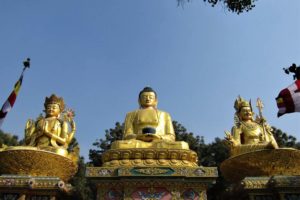
Portrayals of the female Quan Yin often show her wearing a crown of gold, bearing the image of Amitabha Buddha. The image of Amitabha Buddha on Quan Yin’s crown is found throughout Asian Buddhism.
Many traditions maintain that the reference to Amitabha Buddha is that of reverence, paying homage to her teacher.
As mentioned earlier in this text, from the Tibetan Buddhist perspective, Avalokiteshvara is an earthly manifestation of Buddha Amitabha, whose human incarnation and reincarnations are the Dalai Lamas.
Beloved Goddess of Infinite Love & Compassion
The introduction of a clear feminine principle
Quan Yin’s importance to Chinese religion in general, and Buddhism specifically, is the introduction of a clear feminine principle into Chinese religion.
There are similar comparisons to be made with Catholicism and the Virgin Mary. Both are manifestations of the caring, compassionate mother. Both are eternal in their appeal, offering to help unconditionally anyone who prays to them.[30]
Beloved goddess of infinite compassion
To this day, Images of Quan Yin and Avalokiteshvara, can be found in Buddhist temples throughout the world. Quan Yin is as beloved today as she/he has ever been, and her/his endurance and popularity are testament to this deity’s importance within the Buddhist world.
Whether male or female, the messages of infinite love and infinite compassion are ultimately without gender and are the very foundations upon which the Buddhist religion is built.
Notes
[1] Source: (Guan Yin), Northern Sung dynasty, China, c. 1025, wood
[2] Dore, S.J., Henry; Kennelly, S.J. (Translator). “Researches into Chinese Superstitions”, (1914) Tusewei Press, Shanghai, China. Vol. 1 p. 2
[3] Source: sculpture of Khasarpana Lokesvara. Gestures: padma (lotus), varada mudra (gift-bestowing gesture)
[4] Hunnington, John, & Bangdel, Dina, “The Circle of Bliss: Buddhist Meditational Art”, (2003) Serindia Publications, Chicago, Illinois. p. 188
[5] Tsugunari, Kubo, & Akira, Yumaya (Translator), “The Lotus Sutra”, (2007) Revised Second Edition, Berkeley, California: Numata Center for Buddhist Translation and Research. pp. 311-312
[6] newworldencyclopedia.org/entry/Lotus Sutra
[7] Source: Avalokiteshvara One of the Eight Great Bodhisattvas Google Art Project
[8] Baroni, Helen (2002) “The Illustrated Encyclopedia of Zen Buddhism”, The Rosen Publishing Group, NY: NY p.15
[9] buddhanet.net/e-learning/history/kuanyin
[10] Source: Avalokiteshvara, Mount Jiuhua, Anhui province, China – photo Nat Krause
[11] britannica.com/topic/Avalokiteshvara
[12] goddess.ws/kuan-yin
[13] Source: Maio Shan © by Caroline Young Studios. In one version of the myth, Miao Shan is murdered by her father’s servant and is carried to the Underworld on the back of a tiger. Once there, she relieves the suffering of the inhabitants through her music and singing and turns hell into a paradise. Enraged, the King of the Underworld, Yama, sends her back to Earth to the Island of Putuo (Fragrant Mountain), where she carries out her religious practice.
[14] Myth Legends Guanyin
[15] Source: Statue of Guanyin Mt Putuo China
[16] guan-yin-ten-great-protections-goddess-mercy-avalokiteshvara-bodhisattva-compassion
[17] Source: Ryozen Kannon
[18] wiki/Mount Putuo
[19] wiki/Dalai Lama
[20] dalailama.com/the-dalai-lama/biography-and-daily-life/brief-biography
[21] Source: Quan Am of 1000 Eyes and 1000 Hands This wooden statue was created (around 1656) in Bắc Ninh Province Vietnam, for the But Thap Pagoda (now located in the History Museum in Hanoi)
[22] dharma-haven.org/tibetan/chen-re-zig
[23] Source: A Chenrezig Sand Mandala created and exhibited at the House of Commons on the occasion of the visit of the Dalai Lama on 21 May 2008.
[24] 1000-armed-chenrezig-and-what-he-represents
[25] wiki/Guan Yin
[26] Source: Guanyin (Kuan Yin) as Kuo hai, porcelain with white glaze blanc de Chine or Te-hua ware. (Auckland War Memorial Museum)
[27] buddhism-guide.combuddhism/kuan yin
[28] Guan yins Appearance
[29] Source: Avalokiteśvara, Amitabha Buddha, Padmasambhava Kathmandu, Nepal
[30] newworldencyclopedia.org/entry/Guan Yin








